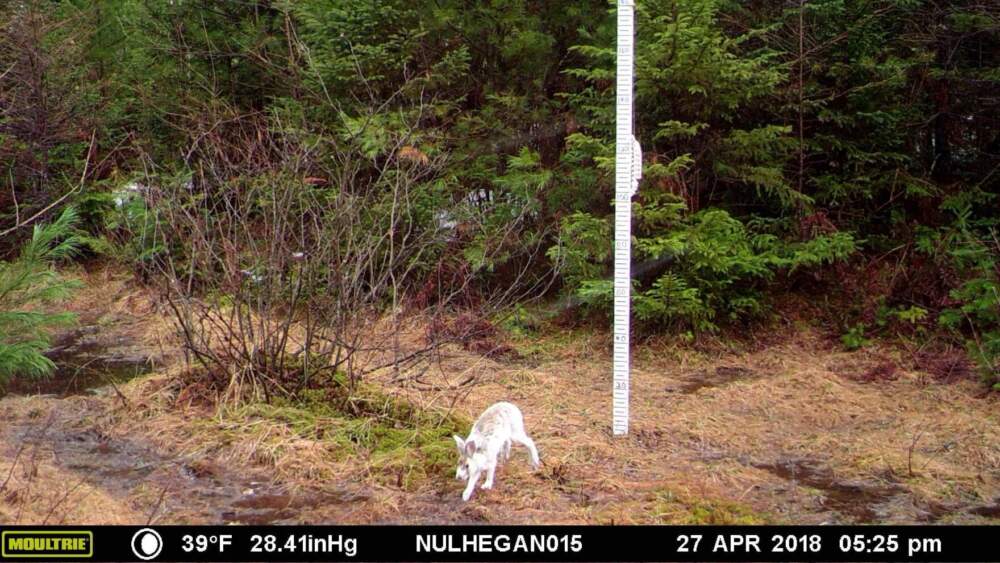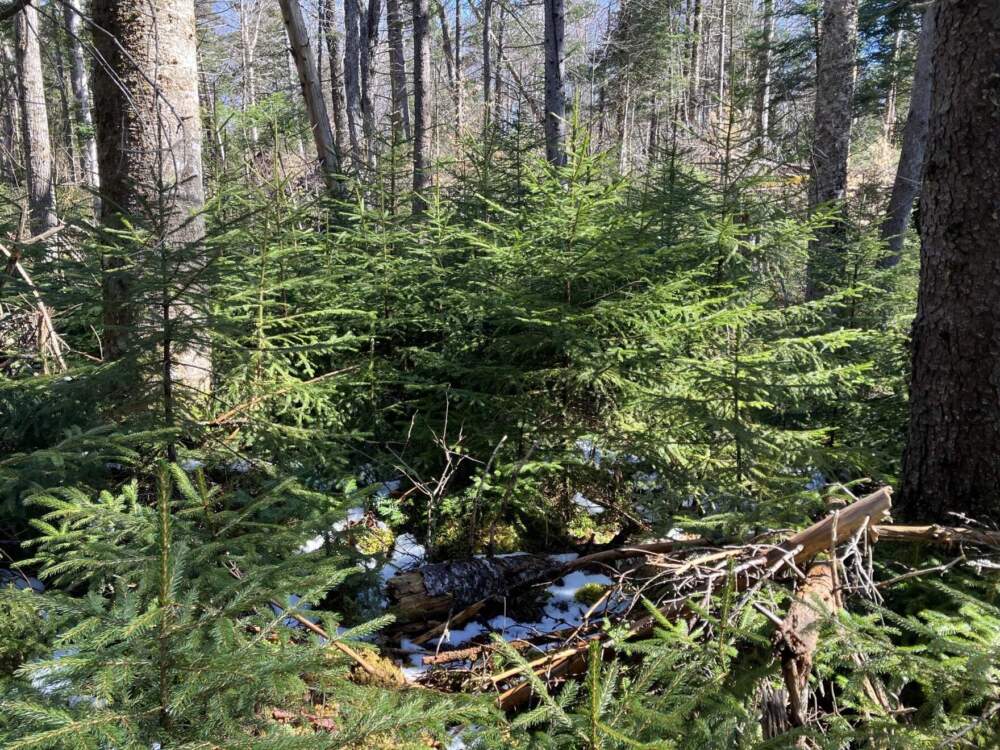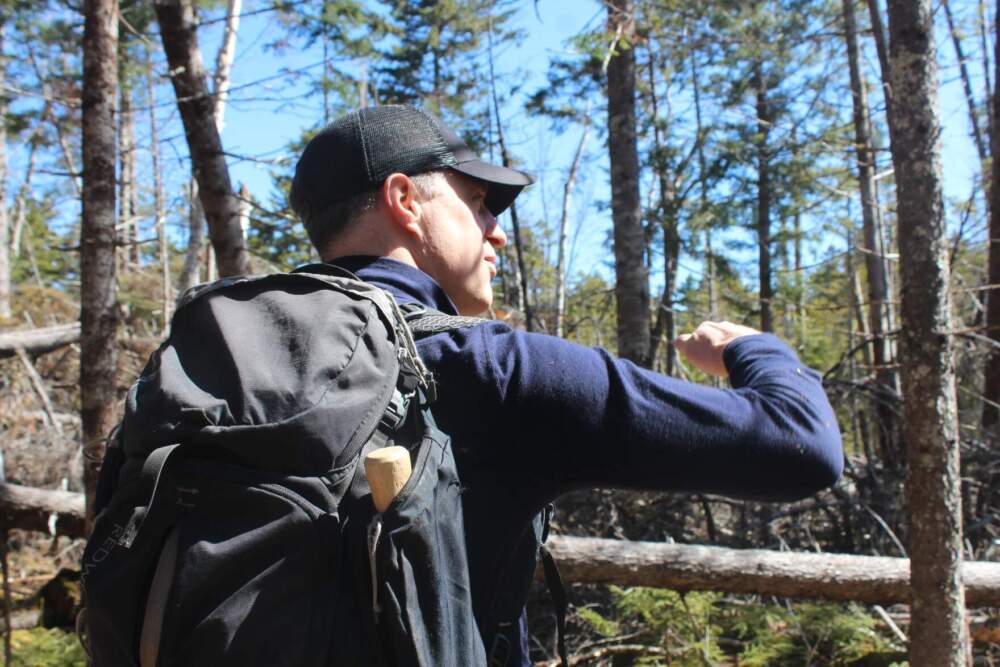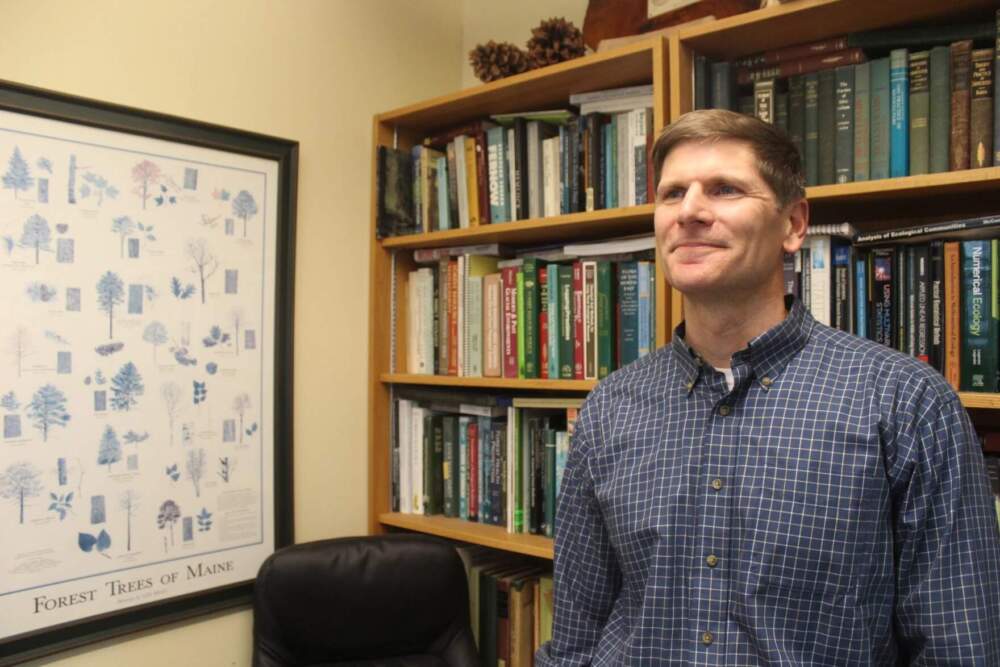On a current heat spring day in New Hampshire’s White Mountains, wildlife biologist Alexej Siren discovered one thing thrilling: snowshoe hare tracks in a fleeting patch of snow.
“We’ve these bigger hind ft which might be out to the facet like that, after which the smaller entrance ft which might be behind it,” he stated, demonstrating how the animals hop to keep away from predators.
It took a tough bushwhack up and over downed bushes and thru a bathroom to get to this place, however we have been standing in what Siren stated is prime snowshoe hare habitat.
Snowshoe hares change their fur with the seasons and the snow. In the summertime they’re usually brown; within the winter they’re white.
However as New England sees much less and fewer snow attributable to human-caused local weather change, some so-called “mismatched” hares are protruding like sore thumbs.
Siren is a part of a coalition of New England researchers which might be learning two concepts about the way to assist, which brings us to the White Mountains.
This little patch of older forest is stuffed with blow-downs, and waist-high spruce and fir bushes are rising up within the house the older bushes have left behind.
It’s dense and troublesome to navigate as a result of it’s onerous to see your ft.
Snowshoe hares wish to nibble on the protein-rich buds of younger hardwoods, however particularly spruce and fir. These 10- 15-year-old saplings have low, dense boughs that assist the hares disguise from predators.
The small bushes additionally create shade and maintain onto snow, so the hares can camouflage.
Siren has been monitoring snowshoe hare populations in New England for greater than a decade, typically by catching and tagging the animals, typically by counting their pellets on the forest flooring. The aim of this journey was to examine some sport cameras.
Snowshoe hares have mild bones and large ft that make them specifically tailored to life on the snow, however their potential to camouflage can also be essential to their survival.
“They’re one of many few colour molting species on this planet that really change their seasonal coats from to be brown within the summertime to white in wintertime, to be camouflaged with snow,” Siren stated.
Nevertheless, when the hares are “mismatched” with their environment, they lose their potential to camouflage.

“The basic after we consider them being mismatched is once they’re white and there is not any snow on the bottom,” Siren stated. “They have been proven to have increased charges of predation throughout these time frames.”
However there’s hope for these animals. Siren says in locations like West Virginia, Pennsylvania and even southern Maine, scientists have discovered snowshoe hares that not flip white within the winter.
He has a grant now to check whether or not introducing a few of these hares to New England might assist the animals right here adapt to local weather change — an answer scientists name “assisted migration.”
“It is a sophisticated answer in a technique, as a result of it is difficult to maneuver animals throughout geopolitical borders,” he stated. “So it is difficult to maneuver them from one state to a different. There are additionally dangers to translocations.”
A few of these dangers embrace taking too lots of the restricted brown hares from the supply inhabitants, such that the trait dies on the market, or placing the dear brown hares in a spot the place they received’t thrive.
Siren hopes this assisted migration might develop into a viable answer within the subsequent decade or so.
Within the meantime, researchers on the College of Vermont are one other repair within the forest itself.

“We will really affect snow habits a bit by altering the character of the forest cover and making an attempt to create circumstances the place it accumulates and in addition melts slower than different spots,” stated Tony D’Amato, who leads the forestry program on the College of Vermont.
Snowshoe hares love what’s known as “early successional forest” — these small bushes that crop up after a giant wind storm, or within the wake of logging.
However D’Amato analysis on recovering paper lands in northern Vermont’s Nulhegan Basin and the Umbagog Wildlife Refuge in New Hampshire and Maine has proven that large clear cuts aren’t the reply right here.
“What we discovered is that, you understand, these smaller openings with shade round them actually do accumulate and really preserve snow loads longer,” he stated.

In some locations, this may be achieved by defending present previous forests, which undergo pure cycles of development and disturbance due to the climate.
Nevertheless, these ecosystems are pretty uncommon in New England, particularly on the area’s non-public lands.
D’Amato hopes harvesting bushes from tiny patches of land right here and there — say a tenth of an acre — and leaving plenty of the wooden behind, may help hold snow on the bottom for longer and create the ecosystems that hold the hares protected.
This analysis is about 5 years previous, and it’ll take many years to see the total influence. However the early outcomes are promising, he stated.
“We’re seeing, on common, over that winter interval, as much as a foot extra snow in these locations, and in some instances even better,” stated D’Amato.

A part of D’Amato’s analysis concerned working with business logging operations to check the financial viability of doing this kind of work as a part of a timber sale.
He stated it is a answer that small landowners might ask their forester to place into follow on their land now.
And that’s vital for it to be scalable, as a result of exterior of public lands, he stated, “The one manner this work is getting completed is that anyone is ready to financially pull this off.”
Again within the woods in New Hampshire, Alexej Siren says discovering an answer for the hares is about greater than saving this culturally vital and charismatic creature.
“They seem to be a actually vital, primary species, a major species of boreal ecosystems,” Siren stated. “And if you did not have them there, then these ecosystems would collapse.”
It’s one thing each researchers are preventing to forestall.
This story is a manufacturing of the New England Information Collaborative. It was initially printed by Vermont Public.

